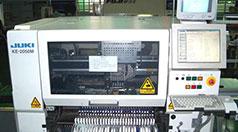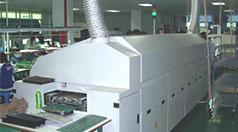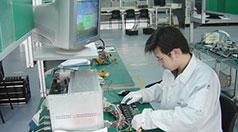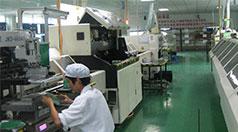Past-In-Hole (PIH) is to print solder paste directly on plated through holes (PTH, Plated Through Hole) of the PCB (Print Circuit Board), and then put the traditional plug-in/through-hole component directly inserted into the plated through-holes that have been printed with solder paste. At this time, most of the solder paste on the plated through-holes will stick to the solder feet of the plug-in components. These solder pastes are reflowed the high temperature of the soldering furnace will re-melt, and then the components will be soldered on the circuit board.

The above method is also called "pin-in-paste", "intrusive reflow soldering" and "ROT(reflow of through-hole), etc.
Speaking of the advantages of this method (Paste In Hole): It can not only eliminate the process of manual soldering or wave soldering but also save labor hours. Apart from that, it can also improve the quality of soldering and reduce the chance of solder short.
However, this method (Past In Hole) has the following inherent limitations:
1. The heat resistance of traditional components must meet the temperature requirements of reflow soldering. General plug-in components usually use materials with lower temperature resistance than reflow soldered components. Because the PIH(Past In Hole) method requires traditional components to be reflowed together with general SMT components, and which must meet the temperature resistance requirements of reflow. Lead-free components are now required to be able to withstand 260°C for 10s.
2. It’s better to have tape-on-reel packaging (tape-on-reel) and enough flat surface to put it on the circuit board (PCB) through the SMT pick and place machine. If it doesn’t work, just it is necessary to consider sending an additional operator to manually place the parts manually. At this time, the required working hours and quality instability must be measured, because the manual plug-in may touch other components that have been placed and positioned due to careless operation. .
3. The solder pads of the component body and PCB must have a standoff (elevated) design. Generally, the PIH process will print the solder paste larger than the outer frame of the solder pad. This is to increase the amount of solder paste to achieve 75% of the through hole filling requirement. If there is no standoff between the component and the solder pad go through Reflow, the molten solder paste will travel along the gap between the component and PCB, resulting in excess tin slag and tin beads, which will affect the electrical quality in the future.
4. Traditional components are best printed on the second side (if there are two-sided SMT). If the components have been printed on the first side, and when SMD is continued on the second side, the solder paste may flow back into the traditional components, causing the possibility of internal short circuits, especially the connector, must be careful.
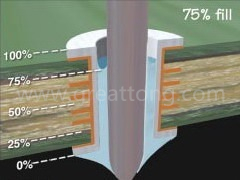
In addition, the amount of solder is the biggest challenge of this method. The acceptable standard of IPC-610 for through-hole solder joints must be more than 75% of the thickness of the carrier board, and some require 50%. (Please refer to the figure below, please refer to IPC-610 section 7.5.5.1 for detailed specifications)
As for the calculation of the amount of solder paste, you can subtract the smallest diameter of the pin from the maximum diameter of the through hole, and then multiply it by the thickness of the circuit board to get it. Remember to x2 again, because the flux in the solder paste accounts for 50%, that is After reflow, that is to say, the volume of solder paste will only be left half of the original printed solder paste.
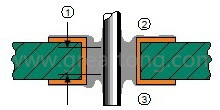
The required solder paste volume ≧ [(Maximum diameter of the through hole/2)2-Minimum diameter of the pin/2)2]× π × thickness of the circuit board × 2
How to increase the amount of solder for through-holes? The following methods are provided for your reference:
1. Reserve enough space near the through hole (PTH) of the circuit board for overprinting.
Discuss with the Layout Engineer (PCB layout engineer) to make more space for printing solder paste near the through-holes that need paste-in-hole. That’s to say, try not to place other pads (welding pads) or other non-products nearby. Solder through holes are required to avoid short circuits during overprint.
It should be noted that the flat space of solder paste printing cannot extend out indefinitely, and the cohesion ability of the solder paste must be considered, otherwise the solder paste will not be able to fully retract the solder pads and form solder beads.
In addition, consider that the direction of solder paste printing must match the direction in which the solder pads extend.
2. Reduce the diameter of the through hole on the circuit board.
Just like the above [Calculation of the amount of solder paste required], the larger the diameter of the through hole, the more the amount of solder paste required, but at the same time, it should be considered that if the diameter of the through hole is too small, the component will be inserted into the through hole. .
3. Use step-up (partial thickening) or step-down (partial thinning) stencil.
This kind of stencil can forcibly increase the thickness of the solder paste locally, which can also increase the amount of solder paste, thereby achieving the purpose of filling the through holes with solder. However, this stencil is about 10% more expensive than ordinary stencil on average.
4. Adjust the proper solder paste, the speed and pressure of the printing machine, the type and angle of the squeegee, etc.
These parameters of the solder paste printer will more or less affect the solder paste printing volume, and the solder paste with lower viscosity will have more solder paste volume.
5. Add some solder paste.
You can consider using a dispenser to add solder paste to the Paste-in-Hole pads to increase the amount of solder paste. Since almost no automatic dispenser is available in the current SMT production line, you can also consider manual dispensing , but must increase the working hours of an operator.
6. Use solder preforms


